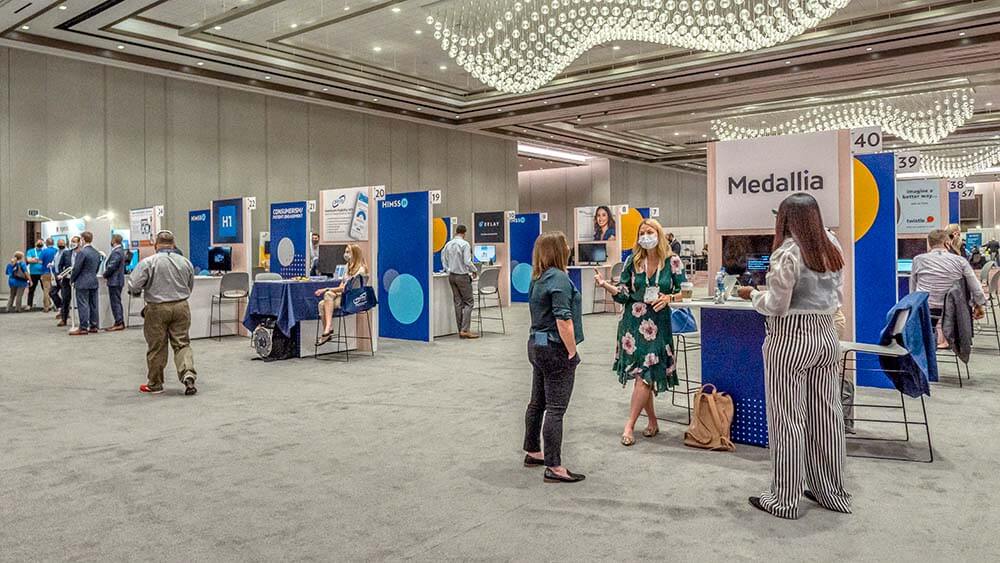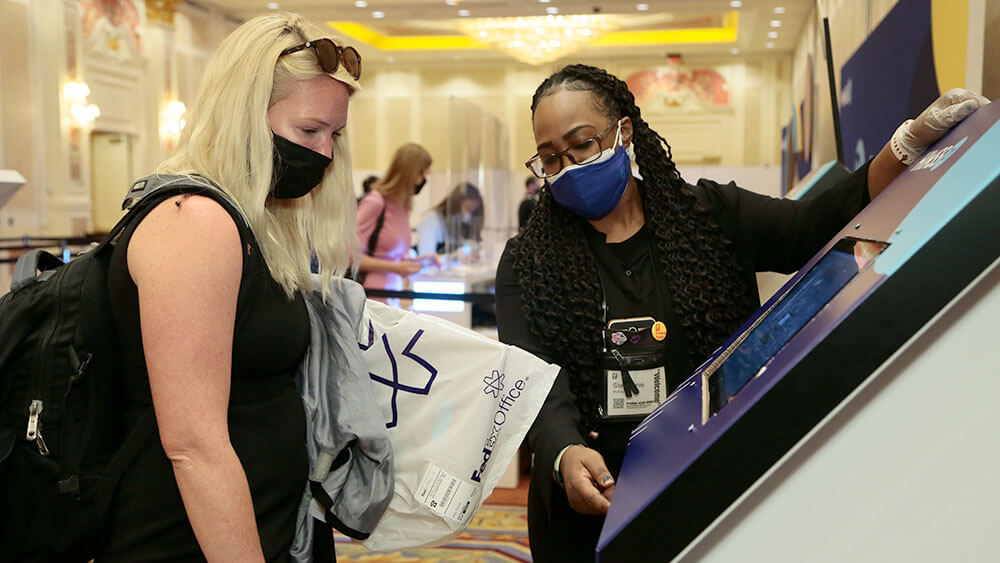
More than 700 companies exhibited at HIMSS’ 2021 Global Health Conference & Exhibition, just more than half the number they typically see at their annual conference. However, more than 236 companies chose to exhibit for the first time, close to the group’s historical average of 250. (Courtesy Caesars Entertainment)
In late June, Convene spoke with Karen Malone, vice president of meeting services and sales for HIMSS North America, to learn how the organization put together a proof-of-vaccination policy in advance of its 2021 Global Health Conference & Exhibition, held in Las Vegas, Aug. 9-13.
A lot has changed since then. In late July, the Delta variant caused a dramatic spike in COVID cases nationwide, prompting the HIMSS21 team to make last-minute adjustments. That included instating a mask mandate for the entire event campus — which spanned CAESARS FORUM, Venetian-Sands Expo Center, and Wynn Las Vegas — in accordance with local guidelines. The team also saw close to 200 exhibitors drop out.
In the end, the conference drew more than 700 exhibitors and close to 19,000 in-person attendees, with almost as many attending online. Recent feedback has been overwhelmingly positive — 95 percent of
exhibitors said they were very happy with the experience, even with the reduced numbers. “They overlooked quantity for quality,” said Malone. “I know it’s a cliche, but it was so true in this case. They said the quality of the conversations was outstanding — they felt they were just stronger… they felt that people were genuinely looking for solutions.”
From a health and safety perspective, the outcome was also a success. As of Aug. 23, only six out of the 19,000 in attendance reported positive test results since the conference — or .03 percent. It is estimated that the rate of breakthrough infections nationwide is .02 percent.
Last week, we caught up with Malone and Anthony Maggiore, CMP, CED, DES, senior manager of meeting services at HIMSS, who broke out their planning process, shared what they learned and what they would do differently, and offered advice for organizers hosting in-person gatherings right now. Here are their takeaways.

HIMSS required all on-site participants to show proof of vaccination and to wear masks. (Courtesy HIMSS)
HIMSS21, by the Numbers
- 25,043 total registrations
- 18,698 in-person registrations
- 16,165 digital registrations (open through Sept. 30)
- 236-plus first-time exhibitors
- 701 exhibiting companies
- 84 percent chose to verify their vaccination status prior to the conference verses on-site
- Consult with the experts. In HIMSS’ case, that meant both health and legal experts. A year out, Malone and her team began conferring with their in-house legal team on everything from what they could — and could not — do when requiring proof of vaccination for right of entry, to navigating state and local laws and crafting clear guidance and communications. In addition, they also created an external panel of medical experts, with whom they started consulting several months before the conference.
- Plan to plan ahead. Communicating key dates and deadlines far in advance is especially important if you plan to require proof of vaccination, Maggiore said, because you want to provide enough time for attendees to get fully vaccinated as well as give them time to cancel if they decide not to attend. “You definitely don’t want to make any announcements post those deadlines, otherwise you’re putting people and yourselves in a really tough position,” he added.
- Scenario planning is key. “We established different plans for all aspects of the conference,” Maggiore said. “We had plans A, B, C, D … all the way through to Z for room sets, food and beverage, registration setups, etc.” That included budget as well. “Budget for your worst-case scenario,” he advised. “COVID is a rollercoaster ride, to say the least. Things have gone up and down so many times throughout our planning process; you really, truly, do need to budget as though your show is going to be [held during] a COVID spike or a COVID peak.”
- Outsource the vaccine verification process. Enlisting the support of Safe Expo and CLEAR Health Pass went a long way. Not only did it lift the burden of verification off of HIMSS, which made sense both from a legal and logistical perspective, it also helped to ensure a safer experience. Case in point: Safe Expo was able to circumvent two attendees who had forged dates on their proof of vaccination and denied them right of entry. By and large, Malone said, attendees appreciated the lengths HIMSS went to in order to keep their information secure and private.
- Make no exceptions. “We believe that our no-exceptions rule was our saving grace,” Maggiore said. “The second you allow even a single exception, you really do open the floodgates that you won’t be able to close. So, we did not allow any medical exceptions. We did not allow any religious exceptions. We did not allow people who were 13 days past their second shot. You truly had to be fully vaccinated by the definition that we had posted on our website.”
- Check in with vendors and suppliers — but keep your expectations realistic. Maggiore stressed that it’s important to ask vendors and suppliers about their plans in terms of health and safety — including if they plan to require proof of vaccination, testing, masking, etc. — ahead of nailing down right-of-entry requirements as well as any communications and terms and conditions. However, he said, “you will not be able to service your show if you require every single vendor employee, every single supplier employee, every single temp employee to be vaccinated — there’s just not enough labor out there.” HIMSS’ vaccine mandate applied to attendees, exhibitors, speakers, and staff, and Maggiore said they sent a letter to all vendor and supplier companies requesting that they supply as much vaccinated labor as possible. “They were all really, really receptive to that,” he said.
- Create a health and safety basecamp. The HIMSS21 Health and Safety Hub page on HIMSS21’s website outlined everything from the right-of-entry process to FAQ to important updates and announcements. Remember to keep language simple and succinct. HIMSS even took an extra step and created a video explaining its guidelines and procedures.
- Offer on-site testing. HIMSS had already decided to offer on-site testing for those who needed test results for travel purposes, but as COVID-19 cases shot up in the weeks prior to the event, they decided to supplement — adding extra testing locations through partner Safe Expo and Eden Health. “We really wanted a turnkey operation,” Malone said. “If someone went and got tested … if they were positive, they were handled by Eden Health from A to Z.” In addition, HIMSS also encouraged attendees to download Nevada’s Department of Human Services’ contact tracking app, COVID Trace.
- Expect — and prepare for — attendees who aren’t following along. “Without a doubt, people are going to show up to the show thinking that you weren’t taking the process as seriously as you are,” Maggiore said. “They’re going to claim they had never read any of the information and they had no idea they needed to be vaccinated.” Training staff and security to be ready for that uncomfortable scenario, as well as flagging unverified attendees in the registration system ahead of arrival, was key to de-escalating those situations. “We found it to be very, very critical,” he added, estimating that they removed approximately 30 people for not supplying adequate proof of vaccination.
- Tighten up registration areas and points of entry. With a large campus that spanned multiple venues, the HIMSS team found it challenging at times to keep satellite registration areas controlled and organized. “People were coming at [registration staff] from all different directions,” Maggiore said. “You had regular transient tourists milling about … those areas are just really hard to control. So, if we were to do it again, we would eliminate satellite registration altogether and force people to go to those much more confined, easy-to-maintain areas.”
- Physical distancing should still play an important role. The HIMSS team configured most of the HIMSS21 campus to allow for distancing, including the meeting spaces hosting the general and education sessions as well as the exhibition areas, where aisles were widened, and, at the eleventh hour, F&B and lounge areas were added in place of canceled booths. The latter earned enough praise that Malone said her team will consider keeping them in the future, if space allows.
- Beef up the digital experience. The HIMSS team chose to run the digital program concurrently with the in-person conference, kicking off on the same day and running through Sept. 30. The digital program, however, “was very different than the in-person content,” Malone said, with the keynote and some other sessions broadcast live as the only overlap. “We didn’t want to replicate all of the content at [the in-person] conference because those are 60-minute-long sessions.” Where did they see room for improvement? Finding more avenues for attendees to engage with exhibitors.
Jennifer N. Dienst is managing editor at Convene.
